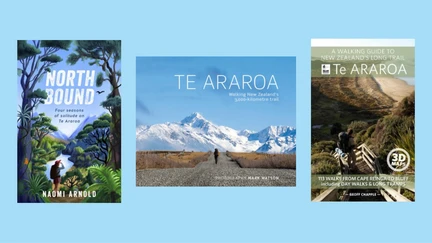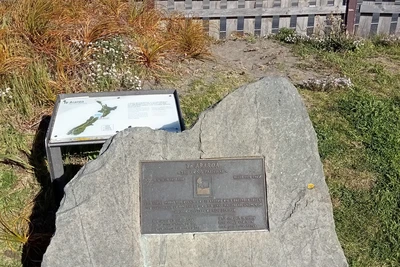Te Araroa Walkers and Wellington Business

Kia tupato kia pai to hikoi
Me te titiro whanui, kia koa
Ki nga taonga kei mua i a koe
Walk the path in safety
Look deeply and learn
From your surroundings
-Inscription on the Te Araroa foundation stone at Shorland Park, Island Bay. The stone marks the end (or beginning) of the North Island section of 3000 km Te Araroa trail.

Just off the path, on the beach side of Shorland Park, Island Bay, there's a stone with a brass plaque. It represents the end (or beginning) of the North Island leg of Te Araroa, the Long Pathway.
Colloquially known as ‘the TA’ it covers a 3000km network of 87 separate tracks/trails from Cape Reinga to Bluff. Over the summer months, usually late in the afternoon, anyone in the vicinity of the park may also notice a weary tramper or two, phone at the ready, trekking poles poking out of backpacks.
They are part of the summer influx of, mainly international, Te Araroa hikers who converge on Aotearoa every year to make the hike southbound (SOBO) or northbound (NOBO). The trail traverses a range of public and private land and is managed overall by the Te Araroa Trust although DOC managed facilities account for approximate 45 percent of the route. Some parts are linked by stretches of road walking, and the trail includes, New Zealand's weather allowing, the Tongariro crossing, a canoe trip down the Whanganui river and of course a ferry journey across Cook Strait. In Te Waipounamu, the South Island, much of the walking is alpine, starting gently with the Queen Charlotte Track through the Marlborough Sounds before entering the Richmond Ranges and Nelson Lakes regions and dropping down into Arthur's Pass.
Te Araroa is gaining in popularity and it's now taking take its place alongside lengthy through hikes such as the Camino de Santiago, (Spain), the Appalachian Way (USA) and the Pacific Crest trail (spanning the eastern coast of the north American continent from Mexico to Canada). Estimates are that at least two thousand people complete the trail in a season (loosely October through to early April). Many more begin but are defeated by injuries part way through, while others complete one or other of the islands. Locals tend to ‘section walk’ – completing the route in stages over a period of years. Age is no deterrent with the youngest walker in 2024-25 being 6 years of age and the oldest in his early 80s.
December-early February is the peak arrival time in Wellington for walkers and while here they tend to rest, recover, and resupply. Although they may not be considered a ‘typical’ tourist, many spend considerable amounts in a few days as they replace shoes, buy new equipment and replenish food supplies.
In the 2024-25 season one of the hikers passing through Pōneke was Jaiden, a 19 year old from Queensland, Australia.
Jaiden was inspired to undertake his hikoi because “I was looking for mountains to climb and New Zealand was the closest place, with great nature. I wanted to challenge myself because many people my age don’t do that”.
Undertaking the TA is not just a physical, and mental, challenge, but it is also a financial one. Discussions on the facebook pages supporting walkers and those preparing to walk, recommend a minimum of NZ$10,000 for the four months or more on trail. If some accommodation comfort is preferred, or some side trips added on, it’s recommended to have a budget of up to NZ$16,000.
Jaiden had the minimum budget of $10,000 and had “worked full time last year, on minimum wage” to save for the trip. “The North Island is super expensive because you have to pay every night for a campsite and it soon adds up".
Arriving in Wellington for a four night stay Jaiden’s highlights to date were “The Tararua ranges for sure. They are the first proper mountains I’ve ever hiked up. The canoeing (on the Whanganui river) was also fun”.
While in Wellington Jaiden saved on accommodation by being hosted by a local Te Araroa Trail Angel. Trail Angels are locals, usually living near a trailhead, who offer accommodation or a backyard campsite, amenities, maybe a meal, transport and advice to those who are walking New Zealand end to end.
Walkers stopping over in Wellington spend their time, as Jaiden did “Resupplying gear and food, sending boxes of supplies on to points south. Doing some touristy stuff like going to the museum”. In total Jaiden estimated he had spent around $1500 during his stay in the city: “I bought a new tent – that was over $700. Then there’s the boxes being sent to supply drops in the south, that was a couple of hundred, plus supplies for the Queen Charlotte track. I met other hikers while I was in town and they were all buying new shoes as well” (A new pair of shoes costs $300-$500. On average a hiker will go through 2-3 pairs over the full length of the TA).
Tom, from local outdoor supply company Coffee Outdoors acknowledges the importance of Te Araroa walkers to their business.
"Te Araroa has grown to be such an important part of our business. We've been open just over two years and we could never have predicted just how many TA walkers we would see through the store. It is a massive boost to us, particularly in January when most of our local customers are elsewhere in the country enjoying the trails on summer holidays. We're a small owner operated store and the added bonus of the TA is that we get to meet so many inspiring and lovely people from all over the world each year. We're constantly asked for recommendations for places to eat and the best places to grab items for resupply boxes that are getting sent from Wellington to various South Island locations."
Next time you see a couple of trampers, fully kitted up and looking a little dishevelled on Lambton Quay, give them a welcoming smile. They’re most likely international visitors fulfilling a physically challenging ambition. They’re in our city for a few days and they’re great for our economy.
"To know Papatuanuku you have to go through slowly, on foot"
- Hone Tuwhare
-Quoted in A Walking Guide to New Zealand's Long Trail: Te Araroa by Geoff Chapple, 2017 : p13
If you're inspired and want to know more about Te Araroa, here are some of the WCL resources available.
- Northbound : Four seasons alone on Te Araroa (2025) by Naomi Arnol
- Not alone : walking Te Araroa Trail through New Zealand (2023) by Tim Voors
- Every effing inch : fear and loathing on Aotearoa New Zealand's long trail - the 3012 km Te Araroa (2023) by Tim Pankhurst
- Adventures with Emilie : taking on Te Araroa Trail in 138 life-changing days (2023) by Victoria Bruce. Also available in eBook format
- Te Araroa : walking New Zealand's 3,000-kilometre trail (2015) by Mark Watson
- Te Araroa : the New Zealand trail (2014) by Geoff Chapple (Ebook)
- End to end New Zealand : following the Te Araroa Trail on a 3,000 km journey from Cape Reinga to Bluff (2012) by Paul Garland
- A walking guide to New Zealand's long trail : Te Araroa (2011) by Geoff Chapple